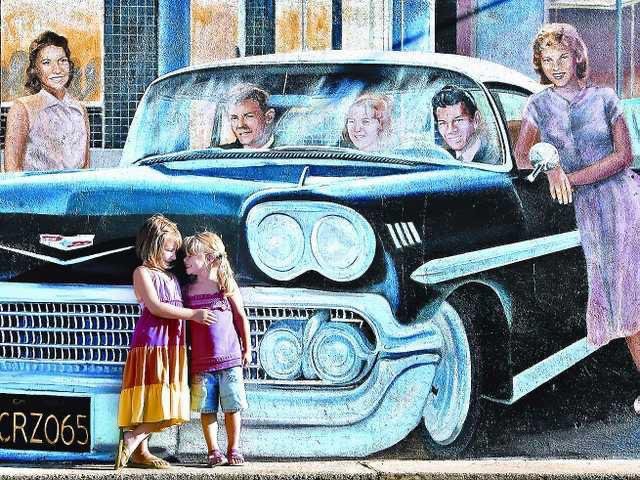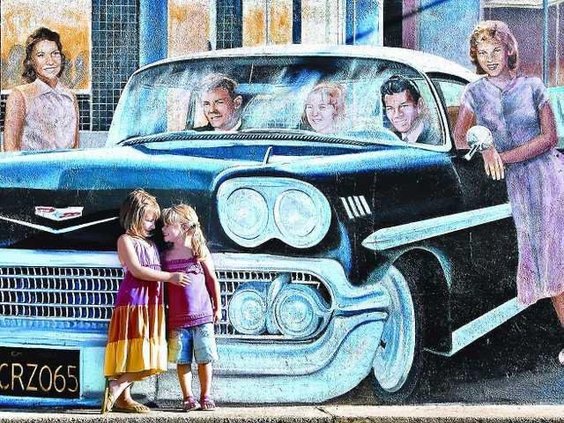If a picture is worth a thousand words, then what is a mural worth?
The answer — all 138 feet long — can be found in the 100 block of North Main Street.
It’s the “Cruising” mural on the northern wall of Accent Carpets.
It depicts a section of the Manteca cruise, circa the early 1960s, on Yosemite Avenue.
More precisely, it is the heart of the cruise on Yosemite from Main Street looking east toward Manteca High going toward the turnaround point near the Patio drive-in.
It is more than just art.
It’s a time machine.
That’s because the faces are of real people.
On the corner, as an example, is a likeness of Manteca Police Officer Tillie DeNero keeping tabs on the cruise standing next to a lamppost.
If you know of anyone who actually cruised Yosemite Avenue when Tillie was an officer, they can share stories of his uncanny sense of knowing when something was up.
There are also more than a few whose teen years are a ways back in the rear view mirror that have stories they cherish today of the hard-nosed cop giving them a break so they didn’t have to face the music trying to explain a youthful indiscretion to parents.
It usually scared them straight, or at least made them not risk doing things such as concealing beer in their car knowing full well they got only one free stay-out-of-the-doghouse card.
The mural contains a number of other local faces behind the wheel, riding shotgun, or hanging out on the curb.
But what makes the mural magical is people whose teen years were spent far away from Manteca and never cruised Yosemite Avenue will look at it and be transported back into time when they cruised in another city, another county, or another state.
It is why most people zero in on “Cruising” as their favorite of the two dozen or so murals the Manteca Mural Society has created in downtown.
People, that is, who have a soft spot in their heart for a 1957 Chevy Bel Air coupe, a 1956 T-bird, or a 1940 Ford pickup.
They were back in the day that fossil fuel guzzling vehicles cost two bits a gallon to run.
It was a time of gas station attendants looking like the Good Humor Man.
Self-serve was rare.
You got your oil checked and your tank-filled without ever getting out of your car.
You also didn’t worry about water being available to wash your windshield or if the squeegee was still in one piece.
Your windshield was cleaned for you and they didn’t leave streaks.
If you got out of your car, it usually was to splurge on an ice-cold glass bottle of Pepsi, Coca-Cola or Hires Root Beer.
And ice cold they were.
The glass soda bottles were “hung” by their bottle caps between lengths of steel strips in a big box cooler where you lifted the lid, fed the machine a dime, and it allowed you to slide your selection forward to free it from its icy tomb.
Maybe it was the glass.
Maybe it was because electricity was cheap.
Maybe it was because they used real sugar.
Or maybe it was because it’s a memory.
But there is not a soda you can buy today from the refrigerated section of the convenience store that have almost universally replaced service bays at stations that sell gas that is as cold or as sweet as what you could buy back in the heyday of cruising.
What brings this up is the 25th annual American Graffiti Festival & Car Show in Modesto this Saturday (June 8 from 9 a.m. to 5 p.m.) and Sunday (June 9 from 9 a.m. to 5 p.m.) at the Modesto Junior College West Campus at 2201 Blue Glum Ave.
It typically features 1,200 to 1,400 cars along with plenty of live music and more. The cost is $10 for adults while children 12 and under are free. (More info is at americangraffitifestival.com)
There is also the 6:30 p.m. Friday (June 7) parade of some 1,000 plus classic cars from 1980 and older in downtown Manteca that runs for more than two hours.
Modesto may not have given birth to cruising but it immortalized it thanks to the cinematic creation “American Graffiti” by filmmaker George Lucas who was raised on a Modesto walnut farm and did his share of cruising during his Downey High days.
“American Graffiti” was filmed entirely in California, but none of the footage was shot in Modesto.
The cruise was indeed a microcosm of being a teen in another era.
To be honest, the car was the vehicle.
Not the obvious, which is Webster’s first definition.
It was the second definition: “a thing to express, embody, or fulfill something.”
The car — or repurposed pickup truck — was simply to get you from Point A at the Fosters Freeze to Point B at the Patio Drive-In — in Manteca or wherever one cruised.
It was the prop, so to speak, that allowed you to hang out with your buds, hatch pranks, test the limits, learn to break ice with people outside your circle, and — if the wheels were all aligned — fall in love.
We look back and like to say it was a time of innocence.
Rest assured, there were plenty of older people around at the time who thoughts about cruising likely mirror ours we harbor today about TikTok and such.
Cruises had their influencers.
Participants rang up “likes.”
They were the cool people.
And more than a few people wanted to be a cool kids or at least be in the same orbit.
That said cruising — for better or worse — required you to be face-to-face with people.
You had to communicate with others without hiding behind a keyboard.
It allowed you to see flaws in those who were cool.
Do not misunderstand. Coolness in the 1950s and early 1960s was scripted like TikTok videos.
Perhaps being cool in the 1950s was a bit more spontaneous, given the drive to have a popular personality didn’t morph into a full-blown brand.
Yes, there were those who were carbon copies of the caricatures of the day. Think Richie Cunningham. Potsie, Ralph Malph. Chachi. Joanie Cunningham. And, of course, “Fonzie.”
Their facades were anchored somewhat in reality and not deepfakes, if you will.
People have always tried to project a certain image, or — in 1950s lingo — coolness. It’s called being human.
But to tightly control an image to set up a standard that others who never interact with you face-to-face that feel pressure to emulate you because you’ve piled up more likes in a minute than a gas station did crates of soda bottle empties over an entire summer is a big disconnect.
It is why it was easier as a teen to cruise “the world” that was defined as the main drag in your hometown or a nearby city than it is to cruise the World Wide Web with a smartphone as your vehicle.
Keep your nose stuck in the screen long enough and you’ll miss the nuisances of life that will just pass you by.
Think of the blonde in the white T-bird.
Enough said.
This column is the opinion of editor, Dennis Wyatt, and does not necessarily represent the opinions of The Bulletin or 209 Multimedia. He can be reached at dwyatt@mantecabulletin.com






